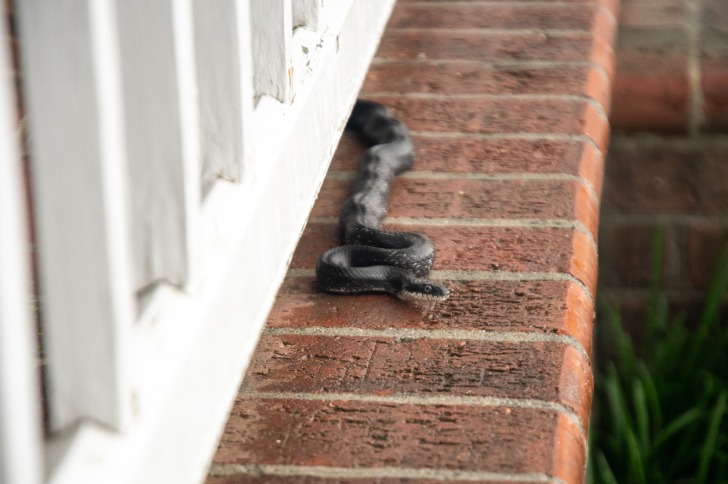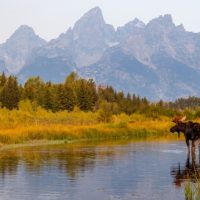Wisconsin is known as America’s Dairyland, and it’s one of the largest dairy-producing states in the country.
In addition to cows and its famous cheeses, the Badger State has plenty of snakes.
The good news is most of them are harmless.

Contents
So… Are There Snakes in Wisconsin?
Yes.
22 snake species call the state home.
Most of these, like the garter snake, pose no real danger to humans.
However, there are two species that you should steer clear of.
Snake Species in Wisconsin
Let’s take a look at the most common species of snakes in the Badger state and the two venomous species you should avoid.
Rattlesnakes
We’ll start with the scary part.
There are two species of rattlesnake found in Wisconsin.
Rattlesnakes are responsible for 74% of snakebite deaths in the U.S., and they bite about 8,000 people a year.
However, only two people in the state have died due to rattlesnake bites since 1900.
Bites in Wisconsin are also very uncommon, with one person being bitten every 4 years.
Rattlesnakes have a rattle at the end of their tail.
When they are threatened, they will shake their tail.
This creates a threatening rattle sound that ideally warns predators away.
The timber rattler is the most concerning.
Timber rattlesnakes are highly venomous.
They typically bite if they are accidentally stepped on or someone attempts to pick them up.
They are large snakes and can reach 5 feet in length.
They have yellow, orange, or gray bodies with a zig-zag pattern that runs down their back.
They are not common and are protected by law due to their low populations.
The Eastern Massasauga is even less common.
This smaller rattlesnake is often called the pygmy rattlesnake.
This species is dangerous, but it’s less venomous than the timber rattler.
The species is considered threatened nationwide and endangered in Wisconsin.
Garter Snake
Garter snakes are the most common snakes in Wisconsin.
They can be found in every county in the state, and they make their home in all five of the state’s habitat types.
In addition to the wilderness, these snakes are perfectly at home in the suburbs, which makes them the most likely snakes you’ll encounter.
Three species of garter snake live in the state, as well as a few related species like the ribbon snake.
The common garter snake is the most common snake found in Wisconsin.
Garter snakes grow to 2 to 4 feet long.
Most have three stripes that run down their back, which resemble a garter.
They are harmless to humans.
Milksnake
The milksnake is the most brightly colored snake found in Wisconsin.
It has a red body, and yellow bands bordered with black.
The snake is not venomous, but it resembles a coral snake, which is highly venomous.
It also shakes its tail, in an attempt to seem like a rattlesnake.
It gets its name because it was once believed to drink milk from cows.
This is probably because it is often found in dairy barns.
However, it’s not cow milk it wants.
Instead, it feasts on the rodents commonly found in barns.
Is it Safe to Go on a Trek in Wisconsin?
Yes.
You can enjoy Wisconsin’s natural wonders safely.
However, like any wilderness area, there are plenty of dangers you should be aware of when exploring the state.
Severe Weather
Wisconsin gets its fair share of severe weather.
In the summer months, you can expect thunderstorms.
The state has about 15 severe storms each year, which can produce hail and tornadoes.
In the winter, Wisconsin gets lots of snow.
Most of the state averages 40 to 50 inches of snow each year.
The snowbelt, however, can get 100 inches or more of snow.
The weather can cause heat stroke in the summer and hypothermia in the winter.
Bears
Black bears aren’t usually aggressive, but they can be dangerous.
They are large and powerful animals with sharp claws.
If you see one, just keep your distance.
Water Currents
Wisconsin’s rivers can be deceptively powerful.
They may look calm, but their normal flow can sweep an adult off their feet and downriver.
The sandbars are unstable and can give way while you stand on them.
Wolves
Gray wolves are beautiful animals.
They don’t typically attack humans, but attacks have occurred.
They have sharp teeth that they use to kill and eat their prey.
They hunt in packs, so you are likely to encounter more than one of them.
Interesting Snake Facts in Wisconsin
The gophersnake or bullsnake is the largest snake in Wisconsin.
It can grow to 80 inches in length.
The snake was recently mistaken for a python, which can be dangerous.
In 2016, the police department searched for a gopher snake due to concerns it was a python.
The water snake is another common snake in Wisconsin, particularly around lakes and rivers.
This snake is brown or gray, with darker patches on its body.
It’s sometimes mistaken for a water moccasin, which is highly venomous, but water moccasins are not found in Wisconsin.

3 Safety Tips for Exploring Nature in Wisconsin
1. Be Prepared for the Weather
Because Wisconsin can have severe weather, it’s important to be prepared before heading out.
Check the weather before you leave, and avoid going out if severe weather is in the forecast.
Even if the forecast is clear, you should prepare for the worst.
In the winter months, bring plenty of warm clothing and a way to start a fire.
In the summer, bring plenty of water.
2. Check-in With Someone
You should let someone know where you are going, and when they can expect you back.
If you aren’t back, they can let the authorities know.
This is particularly important if you are exploring on your own.
3. Keep Your Distance From Wildlife
If you spot any local wildlife, keep your distance.
Most animals can be dangerous if they feel threatened.
As long as you don’t get too close, you should be fine.
If an animal acts aggressively, back away slowly.
Don’t run or threaten the animal.
Summary
Wisconsin has plenty of snakes.
There are 22 species in the state.
However, poisonous snakes are rare in the state.
The Badger State has lots of wilderness, lakeshores, mountains, and woodlands, which makes it a great place to explore.
Wisconsin Safety Overview
READ THE FULL REPORT: Wisconsin Safety Review
Safety Index:
- OVERALL RISK: MEDIUM
- TRANSPORT & TAXIS RISK: MEDIUM
- PICKPOCKETS RISK: MEDIUM
- NATURAL DISASTERS RISK: MEDIUM
- MUGGING RISK: MEDIUM
- TERRORISM RISK: MEDIUM
- SCAMS RISK: MEDIUM
- WOMEN TRAVELERS RISK: MEDIUM
Frequently Asked Questions
Can you see snakes anywhere in Wisconsin?
Yes, some snakes, including the common garter snake, can be found in every area of the state.
What's the largest snake in Wisconsin?
The bullsnake, also known as the gopher snake, is the largest snake in the state.
It can grow to nearly 7 feet long.
While its size is very intimidating, the snake is harmless to humans.
What should I do if I see a snake in Wisconsin?
If you see a snake, the best thing to do is move away from it and admire them from a distance.
It’s important to note that some snakes, including rattlesnakes, are a protected species.
If you see these snakes in an inhabited area, you should call the local wildlife authorities.
They can move them to a safer location.











